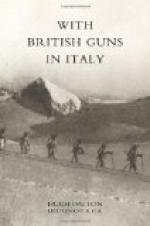Next day I lunched with my friends the Marinis, at their charming Villa on Monte Parioli, and in the afternoon Signor Marini offered to act as my guide to places of interest. We took the tram to the Piazza del Popolo, which was laid out in 1810 under the French Empire, perfectly circular and symmetrical, thus differing from the more Italian of Roman Piazzas, such as the elongated and quite unsymmetrical Piazza di Spagna. We passed along the broad embankment beside the Tiber and through the Square of St Peter’s. Just outside the gates of the Vatican, my guide pointed out to me the little shabby building occupied by the Giordano Bruno Society, symbolic of the brave defiance thrown out, all down the ages, by poverty and the spirit of freedom and intellectual honesty, in the face of wealth and power and oppression, intellectual bondage and the dead weight of tradition.
My guide thought that, out of the wreck of her material defeat and disaster, Russia would perhaps give a new spiritual religion to the western world, to take the place of old forms now dead, and historic organisations which, having lacked the audacity and the wisdom to remain poor when riches were within easy reach, had now become visibly and irremediably detached from the life of the people. He did not fear, as some did for France, a clerical revival in Italy after the war. For the Italian branch of clerical power had shown itself in the hour of Italy’s deadly peril to be largely lacking in Italian patriotism, and to have been scheming for the maintenance, if not the expansion, of Austrian dominion, and, perhaps, for the re-establishment by the aid of Austrian and German bayonets, or Turkish, if it had been necessary to solicit them, of the Temporal Power of the Papacy over Italian citizens and Italian soil. I saw one of the Swiss mercenaries of the Papacy gazing forth a little contemptuously through a door of the Vatican upon the secular outer world.
From St Peter’s we drove up the Janiculum, stopping on the way at the convent of S. Onofrio, where Tasso passed the last three weeks of his life and where a Tasso Museum has been accumulated. Very admirable is the equestrian statue of Garibaldi on the Janiculum, both as sculpture and for its details of intention, such as that sideways turning of his head, looking down hill at the Vatican, as though saying, “Non ti dimentico,”—“I do not forget you, my old enemy.” The view of Rome from this point is magnificent, the best that I have seen, though the view from the Pincio only just falls short of it.
Thence, passing outside the old city walls through the Porta San Pancrazio, we stood on ground made memorable by Garibaldi’s defence of the Roman Republic in 1849, and went down, past the. Pope’s monument to the French who died fighting to defend his Temporal Power against the Garibaldini, into the beautiful garden of the Villa Pamfili. “Attendono il finale risorgimento,"[1] says the Pope’s Italian version on the monument. It is an ironical phrase in view of the history of the next twenty years. “They did not have long to wait,” I said, “a bird in the hand is worth two in the bush.” And my guide said, I thought well, of the French that they are a people of great gifts and of most generous mind, but that their rulers have often showed “un po’ di volubilita, un po’ di fantasia.”




